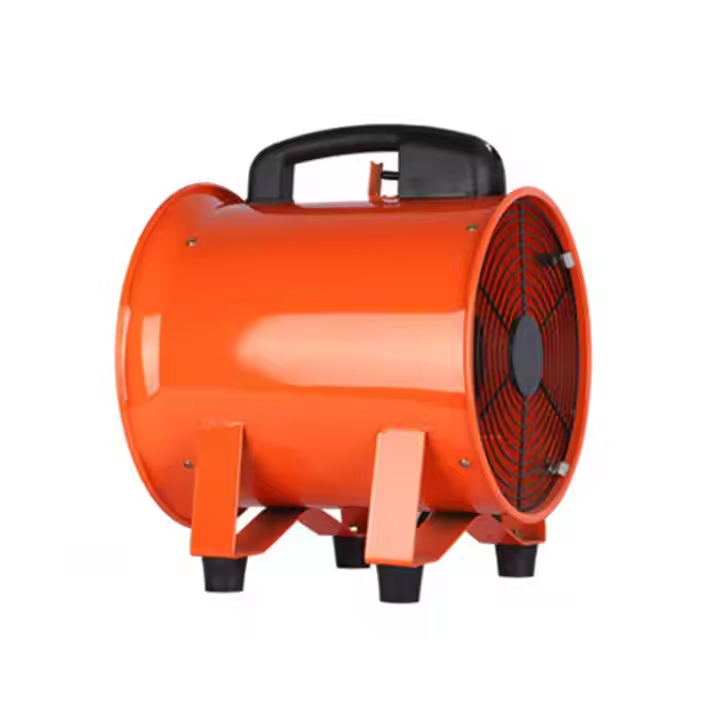Understanding Duct Fan Noise Sources
Common Causes of Noise in Ventilation Systems
Duct fans which are indispensable for a ventilation system can generate noise on account of the mechanical parts like blades, motors and the like. These things all make noise as it operates, especially if these appliances are not kept or designed for quiet operation. Additionally, turbulence of air flow is another major source of noise generated by ventilation systems. Noise is also generated by turbulence resulting from incorrect ducting design, such as sharp bends or obstructions that inhibit unobstructed air passage, causing turbulence and turbulence noise. Normal wear and tear on duct fans can cause a rise in noise level. With age, its bearings and mounts are likely to wear out, which can cause vibration and loud noise during operation.
Impact of Noise on Industrial and Building Environments
Besides, excessive noise of duct fans is not conducive to industrial production and building use. At industrial sites excessive noise can result in low productivity of workers or discomfort for them. And those blaring, bone-rattling levels of noise over sustained periods? Those could even lead to health problems such as stress or hearing loss, according to several health organizations. In buildings, noise interferes with occupant enjoyment, rendering tenure less attractive and potentially non-compliant with building codes that limit excessive noise. Noise control of the duct fans and how it can be used to help prevent the spread of diseases and maintain a healthy building with pure air is essential.
Core Strategies for Duct Fan Noise Reduction
Installing Acoustic Silencers in HVAC Ductwork
Acoustic attenuation devices are essential to the reduction of the noise from HVAC ducts. They work by attenuating airborne sound, focusing on the undesirable frequencies of sound produced by air borne passageways. Most silencers are used at strategic locations in the ductwork system according to a common voguish practice to reduce the noise level to a maximum extent as per industry standards. They should be installed properly after careful consideration of airflow direction & ducting design for best dampening performance. 90 cases St u dies were conducted to show the significant noise reduction in systems with acoustic silences. Such real-world examples show how a formerly disruptive environment has been converted into a much quieter environment—providing comfort for occupants.
Vibration Damping Techniques for Fan Mounting
Vibration damping is also integral to the strategy for noise suppression at the source, which is centered on isolation of the fan generated vibrations. Vibration isolation mounts are basic pieces which allows to reduce the transmition of the working noise. Various other materials (e.g. rubber, damping materials and the like) are used to provide for high degree of isolation. These components are placed at specific locations for vibration absorption and to restrict the transmission of sound. This is proved with engineering assessments to have low noise exposure, with this technology applied in both industry and building.
Optimizing Duct Layout for Noise Control
Optimal ductwork design also plays a significant role in managing noise in ducted ventilation systems. To reduce noise amplification, the design should attempt to minimize the presence of sharp bends and transitions. Correct duct size is important for this as it affects air speed and usually slower air speed means less noise. By following established protocols and best practices for duct design, a more serene atmosphere can be created for better comfort. Through incorporating these concepts, a better acoustic sound attenuation can be achieved while preserving the efficient operation of the ventilating system.
Through these strategies, we can effectively tackle noise issues associated with duct fans in various environments, ensuring a balance between functionality and comfort.
Advanced Solutions for Specific Applications
Noise Reduction in Laboratory Ventilation Systems
In laboratory applications, the noise level is high, in order to comply with standards and safety. Laboratory ventilation systems The silent whisper Noise in laboratory ventilation systems needs to be decreased, as loud noises can disrupt sensitive experiments and overall workplace comfort. Investing in duct fans that are constructed for laboratory use is, therefore, a must. These dedicated extractor fans are highly specified and thermally insulated, to reduce noise with no loss of air flow performance. Successful applications including Universities and Research Division is testament to the effectiveness of purpose-made duct fan solutions for noise level reduction in laboratories. Laboratories can keep conditions favourable for research and experimentation with the right equipment.
Quieting Industrial-Scale Duct Fans
Areas of application Industrial fans: Large dimension fans need ventilation, too. Tackling the issue, high end fan technology has evolved to reduce noise. For instance, when the dynamic balance propellers and the soundproofing material are applied, much of the aerodynamic noise and the mechanical noise are drastically reduced which allows smooth operation. Statistical evidence from areas such as the manufacturing and processing industries suggests that adopting technology can result in a substantially quieter environment and safer workplace. The use of silencing solutions allows industry to operate at peak performance levels, without suffering from the disruptive impacts of too much noise.
Retrofitting Existing Building Ventilation Systems
Adding to older-building ventilation systems with noise abating components is one way to improve indoor acoustics. The process adds materials and technology in the right places including sound insulation, silencers, and the balancing of dynamics for an integrated, -turnkey idea. With products such as acoustic panels and vibration-damping mounts, it’s possible to reduce sound levels a great deal, which will make conditions a lot more comfortable for humans. Examples of good practice from office and educational buildings show the influence of retrofitting for noise control. So, even without an entire systems overhaul, buildings can gain functionality and a quieter environment by retrofitting existing systems.
Maintenance Practices for Sustained Noise Control
Balancing Fan Blades for Smooth Operation
Fan Blades should be balanced to ensure smooth operation and noise prevention. Unbalanced fan blades can create vibration in a fan system and can also contribute to system noise. It is also due to the wear and tear of the china itself which increases maintenance costs. When it comes to balancing fan blades, there is a specific process to follow, special tools to be used and safety precautions that need to be considered. This usually entails shutting off the fan, using a balance kit, and taking small adjustments until the fan runs smoothly. According to maintenance good practice, periodic checking and adjustment are necessary to keep the system at the maximum of free from harmful vibrations, which will ensure optimal fan performance and minimum noise level.
Cleaning Protocols to Prevent Noise Amplification
It is important to keep the duct fans clean in order to minimize the noises amplified and the fan running properly. Dust buildup on fans can cause an increase in fan noise, and is capable of causing system instability due to airflow restriction. To prevent these problems, regular cleaning is crucial. That means cleaning it out, including vacuuming it out and wiping fan blades and filters. Running your equipment in an environmentally conscious way, using green or organic cleaning products, is a reflection of this care and extends the life of your ventilation system as well as the way that it operates. Maintaining a good clean system is more than a housekeeping chore, it becomes a strategy for preventing noise and interference.

